1. Introduction
 The Kingmax Group, formed in Taiwan in 1989, set a division of labor by creating a number of companies: Kingmax Semiconductor Inc., which produces and markets memory products; Kingpak Technology, which specializes in package testing and PCBA production; and Kingmax Digital, which produces and markets flash memory products.
The Kingmax Group, formed in Taiwan in 1989, set a division of labor by creating a number of companies: Kingmax Semiconductor Inc., which produces and markets memory products; Kingpak Technology, which specializes in package testing and PCBA production; and Kingmax Digital, which produces and markets flash memory products.
We received from Kingmax its DDRII 667 memory modules from the Mars series, which is embedded with a red ASIC decoder chip and the company's proprietary
TinyBGA color packaging technology. This new Kingmax memory product is 100%
counterfeit-proof, according to the manufacturer and symbolizes the fiery, strong heart of Mars, the god of
war :-)
In terms of technical specifications, the Mars DDRII 667 is endowed with up to 8.6GB/s of memory bandwidth and fully supports Prescott/Tejas 1067MHz FSB while direct integration of ODT technology increases system stability. With a low 1.8 volts of working voltage that cuts power consumption by 50%, the Mars DDRII 667 can run at JEDEC standard 4-4-4-12 latency timings, making it the perfect support for all new-generation DDRII high-speed computers. Just as DDR has replaced SDRAM, DDRII -with its new specifications and powerful functions- will soon replace current DDR specifications as the market mainstream.


Each module comes in a box with a simple guide for the user.


KINGMAX has developed high-tech anti-counterfeiting measures to protect the rights of end-users by adding to each DDR2 memory module a red ASIC decoder chip, which uses Kingmax's TinyBGA "color compound" packaging technology.
Packaging technology, in particular, determines a memory module’s working stability. Currently, most DDRs and SDRAMs use the TSOP packaging method, but BGA packaging is mandatory for DDRII according to JEDEC standards. With BGA packaging, there is a wider space at the bottom of the chip, which allows for a higher pin count while guaranteeing larger spacing between pins and meets the higher density signal input/output requirements essential for DDRII. Furthermore, BGA packaging offers other advantages, such as easy chip installation, better electrical performance, less delay in signal transmission, which allow for high-frequency operation and excellent heat dispersion.
Kingmax developed BGA packaging technology eight years ago and has successfully utilized it in the mass production of its SDRAM and DDR products. This proprietary patented technology – TinyBGA-- is highly recognized in the industry. Kingmax has used this cutting-edge technology since the SDRAM PC66/100 era, when it was used only with high-end semiconductor products (e.g. CPU). With over eight years of experience, Kingmax is extensively equipped to handle the exacting challenges faced in BGA packaging, including technical expertise, equipment upgrades and personnel training.
Features
- 240-pin, DDRII memory module.
- Voltage: 1.8V, reducing power consumption by approximately 50%
- Memory signal termination inside the memory chip ("On-Die Termination") to prevent reflected signal transmission errors.
- Operational enhancements to increase memory performance, efficiency and timing margins.
- Great heat dissipation capabilities
- Exceptional memory functionality and efficiency.
- Global lifetime warranty.
- Bi-directional data strobe (DQS-DQS#)
- Differential clock inputs (CK and CK#)
- DLL aligns DQ and DQS transition with CK transition
- Auto & self refresh capability (8192 Cycles / 64ms)
- Double-data-rate architecture; two data transfers per clock cycle
- Programmable Read latency : 3, 4 and 5 (clock)
- Programmable Additive Latency: 0, 1, 2, 3 and 4
- Programmable Burst length:G4 or 8
- Programmable Burst type (Sequential & Interleave)
- Edge aligned data output, center aligned data input
- Serial presence detect with EEPROM

2. Test Configuration & System
After installing the Kingmax 2X512MB 667MHz memory modules in our test system, in dual channel mode, we ran CPU-Z in order to see how they were identified by WinXP (SP2).

The first tests were done at 533Mhz with 3-4-4-11 timings, a setting which is automatically detected from the SPD. Below you can see further details for the memory and the CPU:

The next step was to set the memory to run at 667MHz. For this we had to change the timings to 4-5-5-13 and increase the FSB from 200 up to 250. The configuration is given below.

Finally, we tried to find the highest operating frequency for the memory. With the contribution of Memtest86+, we managed to set up the memory modules to run up to 693MHz. The FSB had to be set to 260. The CPU at this point was running at 3.90GHz while the memory voltage was set to 2.2V. At higher speeds, even at 698 for example with lower timings of 5-5-5-15, Memtest86+ reported errors. Despite this, the confirmed 693MHz is quite good.
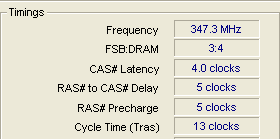

In Memetest86+, the reported bandwidth for the highest overclocking speed was 3469MB/s and 3752MB/s for the Kingmax and the OCZ memories respectively.
In the following pages, we will be comparing the performance of the Kingmax memory modules against that of the OCZ PC5300. The nice thing here is that both memories are very similar, something which makes for a good comparison.

OCZ
Here's a rundown of our testbed:
System Specifications
CPU: Intel Pentium 4 530 3.00GHz
Cooler: Arctic Cooling Freezer 7
Case: Antec
Motherboard: Asus P5AD2-E Premium
Power supply: CoolerMaster 450W
Memory: Kingmax, OCZ PC5300 (dual channel)
VGA: Aopen Aeolus 6800Ultra PCI-E
Hard Disk Drive: WD800JD 80GB 7200RPM
OS: Windows XP Pro SP2
Drivers: 7.1.8.4
DirectX: v9.0c


Benchmarks & Applications used
- Memtest86+-1.60
- Sisoft Sandra 2005
- PcMark04
- Performance Test V5.0 ( PassMark)
- Half Life 2 - VST
- CPU-Z v1.29
3. SiSoft Sandra 2005
 SiSoftware Sandra is a 32 and 64-bit Windows system analyser that includes benchmarking, testing and listing modules. It tries to go beyond other utilities to show you more of what is really going on under the hood so you draw comparisons at both a high and low-level in a single product.
SiSoftware Sandra is a 32 and 64-bit Windows system analyser that includes benchmarking, testing and listing modules. It tries to go beyond other utilities to show you more of what is really going on under the hood so you draw comparisons at both a high and low-level in a single product.
You can get information about the CPU, chipset, video adapter, ports, printers, sound card, memory, network, Windows internals, AGP, ODBC Connections, USB2, Firewire etc.
You can save/print/fax/e-mail/post/upload or insert into ADO/ODBC databases reports in text, HTML, XML, SMS/DMI or RPT format.
This version supports multiple sources of information gathering including: remote computers, PDAs, Smart Phones, ADO/ODBC databases or saved system reports.
All benchmarks are optimised for both SMP & SMT (Hyper-Threading), up to 32/64 CPUs depending on the platform.
Memory Bandwidth Benchmark
Tests how your memory sub-system compares to other systems with the same or similar memory in other systems. The benchmark is based on the well-known STREAM memory bandwidth benchmark.
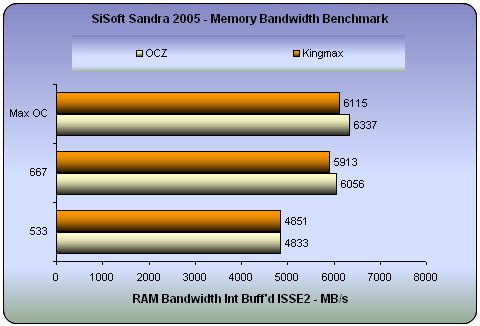
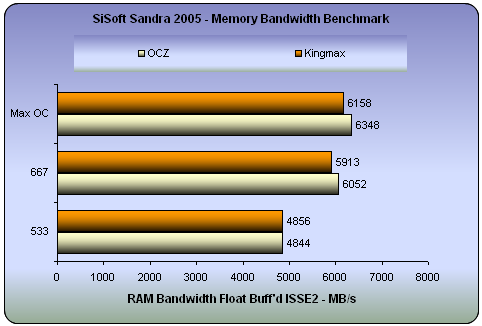
Cache & Memory Benchmark
Tests how your CPU cache and memory sub-system(s) compares to other systems with the same or similar CPU & memory in other systems. The benchmark is based on the Memory Bandwidth Benchmark test.
Combined Index: is a composite figure representing the overall performance rating of the entire Cache-Memory performance in terms of MB/s. The value is the logarithmic average of all the results for the entire address space. (Higher is better, i.e. better performance)
For block sizes that could not been tested - the average of previous blocks is used, thus the size of the memory (as long as it is not comparable to largest cache size) is not significant; all cache sizes are significant - larger caches will result in a higher index.

Speed Factor: is a figure representing the speed differential between the CPU’s cache and memory. The value is the ratio of the fastest cache (i.e. L1) bandwidth to the main memory bandwidth. (Lower is better, i.e. the memory is not very much slower than the CPU’s cache)
As the factor is a ratio, it is useful only in comparing different CPUs and memory sub-systems rather than having a direct, physical interpretation associated to its numerical value.
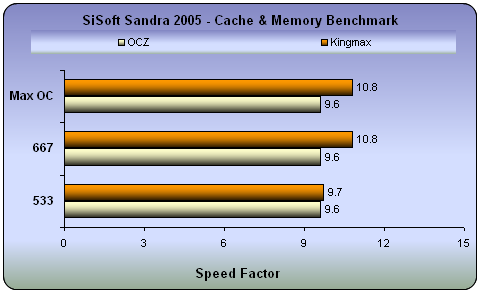
When running at 533MHz, Kingmax seemed to perform marginally better than OCZ, but the differences are truly negligible. At 667MHz and higher however, OCZ reported much better performance than the Kingmax memory.
4. PCMark05
 PCMark05 is an application-based benchmark and a premium tool for measuring overall PC performance. It uses portions of real applications instead of including very large applications or using specifically created code. This allows PCMark05 to be a smaller installation as well as to report very accurate results. As far as possible, PCMark05 uses public domain applications whose source code can be freely examined by any user.
PCMark05 is an application-based benchmark and a premium tool for measuring overall PC performance. It uses portions of real applications instead of including very large applications or using specifically created code. This allows PCMark05 to be a smaller installation as well as to report very accurate results. As far as possible, PCMark05 uses public domain applications whose source code can be freely examined by any user.
PCMark05 includes 4 categorized suites for benchmarking your computer. These include CPU, Graphics, Memory and a Hard Disk Drive benchmark. In our case, we selected to run only the Memory test suite.


Good performance from the Kingmax memory modules. The second graph above shows the PCMarks at 693MHz, the highest speed, where OCZ scores slightly higher.
| PCMark05 Memory Test |
533 |
667 |
693 |
| Memory Read 16MB |
6015.932 |
7304.314 |
7628.858 |
| Memory Read 8MB |
6171.476 |
7515.432 |
7827.724 |
| Memory Read 192KB |
23811.035 |
29519.041 |
30360.902 |
| Memory Read 4KB |
39810.621 |
49174.121 |
51356.512 |
| Memory Write 16MB |
4082.633 |
5039.661 |
5251.743 |
| Memory Write 8MB |
4075.474 |
5040.106 |
5258.876 |
| Memory Write 192KB |
10187.807 |
12610.504 |
13099.578 |
| Memory Write 4KB |
10234.941 |
12671.567 |
13186.920 |
| Memory Copy 16MB |
4286.750 |
5177.871 |
5385.539 |
| Memory Copy 8MB |
4293.386 |
5186.491 |
5185.834 |
| Memory Copy 192KB |
8993.087 |
11141.275 |
11592.097 |
| Memory Copy 4KB |
10209.163 |
12667.734 |
13209.012 |
| Memory Latency 16MB |
7.923 |
9.042 |
9.361 |
| Memory Latency 8MB |
8.281 |
9.498 |
9.811 |
| Memory Latency 192KB |
129.234 |
159.992 |
166.465 |
| Memory Latency 4KB |
757.888 |
938.036 |
976.038 |
5. Performance Test v5.0
 Passmark PerformanceTest is an award winning PC hardware benchmark utility that allows everybody to quickly assess the performance of their computer and compare it to a number of standard 'baseline' computer systems.
Passmark PerformanceTest is an award winning PC hardware benchmark utility that allows everybody to quickly assess the performance of their computer and compare it to a number of standard 'baseline' computer systems.
Twenty seven standard benchmark tests are available in seven test suites plus there are five advanced testing windows for custom benchmarking. CPU Tests, 2D Graphics Tests, 3D Graphics Tests, Disk Tests, Memory Tests and CD/DVD Tests. In our case we selected the Memory suite Tests.
- Memory Benchmarks
This suite contains a number of tests that exercise the memory sub-system of the computer. (Random Access Memory- RAM)
Memory - Allocate small block
This test measures the time taken to allocate & free small zeroed memory blocks (around 100KB block size)
Memory - Cached
This test measures the time taken to read a small block of memory. The block is small enough to be held entirely in cache (if one is present)
Memory - UnCached
This test measures the time taken to read a large block of memory. The block is too large to be held in cache.
Memory - Write
This test measures the time taken to write information into memory.
| Kingmax |
533MHz |
667MHz |
693MHz |
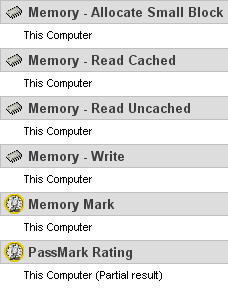 |
 |
 |
 |
Just for comparison reasons, below we present the performance table for the OCZ memory for the same task:
Once again, the Kingmax memory modules showed better performance at 533MHz. But at 667MHz and higher, OCZ was slightly better.

- Advanced Memory Benchmark
Memory Speed Per Access Step Size
The first test type, ‘Memory Speed Per Access Step Size’ accesses a large block, of memory in various sized steps. First, it runs through the block of memory sequentially, accessing every value. Next it runs through the same block again, except this time it accesses every second value. On this occasion, it runs through the block twice in order to access the same amount of data as the initial step. Next it runs through the same block again, except this time it accesses every fourth value and so makes four passes. And so on, until a certain maximum step size is reached.
The size of the block of memory used for this test is one quarter the amount of system RAM. The size of the steps varies from 1 (continuous sequential access), to one quarter the size of the block of memory ( i.e. one sixteenth of the system RAM ).
| Memory Speed (MB/Sec. per Step Size) |
533MHz
(MB/s) |
667MHz
(MB/s) |
Max OC
(MB/s) |
| Kingmax |
| Block Read Speed |
30.73 |
37.22 |
38.22 |
| Block Write Speed |
21.61 |
25.18 |
25.79 |
| OCZ |
| Block Read Speed |
30.10 |
37.56 |
38.89 |
| Block Write Speed |
21.44 |
26.47 |
27.55 |
Memory Speed Per Block Size
When a computer program wants to use a section of memory to store data, it makes a request to Windows for the amount of memory it requires. Windows allocates the memory to the program ( unless system resources are very low ) and returns to the requesting program the address of the first memory slot in the allocated block. It is possible that some programs may request very large amounts of memory. The ‘Memory Speed Per Block Size’ test like the ‘Memory Speed Per Access Step Size’ test, is composed of many steps. During each step of the test, PerformanceTest requests a block of memory and runs through the block measuring the average access time. However on each subsequent step the size of the requested memory is increased, until finally a block close to the size of the system RAM is requested. In this way it is possible to observe the different access speeds for the different sizes of blocks.
Typically it is possible to see very fast memory access for blocks which are small enough to fit entirely into the L2 RAM cache, and slower access times for larger blocks accessed from main RAM. In the case where system resources are low, swapping to the disk may even be required for very large blocks.
| Memory Speed (MB/Sec. per Block Size) |
533MHz
(MB/s) |
667MHz
(MB/s) |
Max OC
(MB/s) |
| Kingmax |
| Block Read Speed |
345.96 |
428.04 |
447.10 |
| Block Write Speed |
240.27 |
297.99 |
310.58 |
| OCZ |
| Block Read Speed |
342.35 |
427.92 |
447.58 |
| Block Write Speed |
238.47 |
297.51 |
311.52 |
Similar performance from the Kingmax and OCZ modules at all speeds.
6. Half Life 2
 Half life 2 is no doubt the most anticipated pc game of all times. Gamers having the excellence of Half Life 1 in mind, as well as the remarkable E3 demo preview, have been anxiously waiting for the much delayed release of HL2.
Half life 2 is no doubt the most anticipated pc game of all times. Gamers having the excellence of Half Life 1 in mind, as well as the remarkable E3 demo preview, have been anxiously waiting for the much delayed release of HL2.
Physics - From pebbles to water to 2-ton trucks respond as expected, as they obey the laws of mass, friction, gravity, and buoyancy.
Graphics - Source's shader-based renderer, like the one used at Pixar to create movies such as Toy Story® and Monster's, Inc.®, creates the most beautiful and realistic environments ever seen in a video game.
AI - Neither friends nor enemies charge blindly into the fray. They can assess threats, navigate tricky terrain, and fashion weapons from whatever is at hand.

With games, the increased FSB in combination with the memory speed, boosted performance. At 533MHz, Kingmax was slightly better while at 667MHz OCZ reported higher framerates. At maximum speed, both memories reported similar performance.
7. Conclusion

The overall performance of the Kingmax DDRII 667 modules was good at all speeds. Pitted against the more expensive OCZ PC5300 in our comparison, the results were very good at 533MHz and 667MHz. At the highest speed of 693 MHz which was confirmed using Memtest86+, performance was equally good although there are others out there that can go faster and better. The good thing is that our Kingmax modules reached the highest speed without any compromise in timings, so that we used the same timings as at 533MHz.
SiSoft Sandra 2005 reported the very good results of 6115MB/s and 6158MB/s in the RAM Bandwidth Integer and Floating Point benchmarks respectively, while in the Combined Index, the reported 11313MB/s was also good. In games, the increased memory speed in combination with the overclocked CPU will increase the frame rate, as happened in our HL2 test where we saw a jump of approximately 30fps when going from 533MHz to 693MHz.

In the e-market, it is not so easy to locate the specific memory modules since they are quite new, but we are sure this will change shortly. The price, according to Kingmax, is around US$85 for each 512MB module but soon, there will be a dual channel edition package. The cost is very reasonable and it is a safe purchase for most PC systems.
